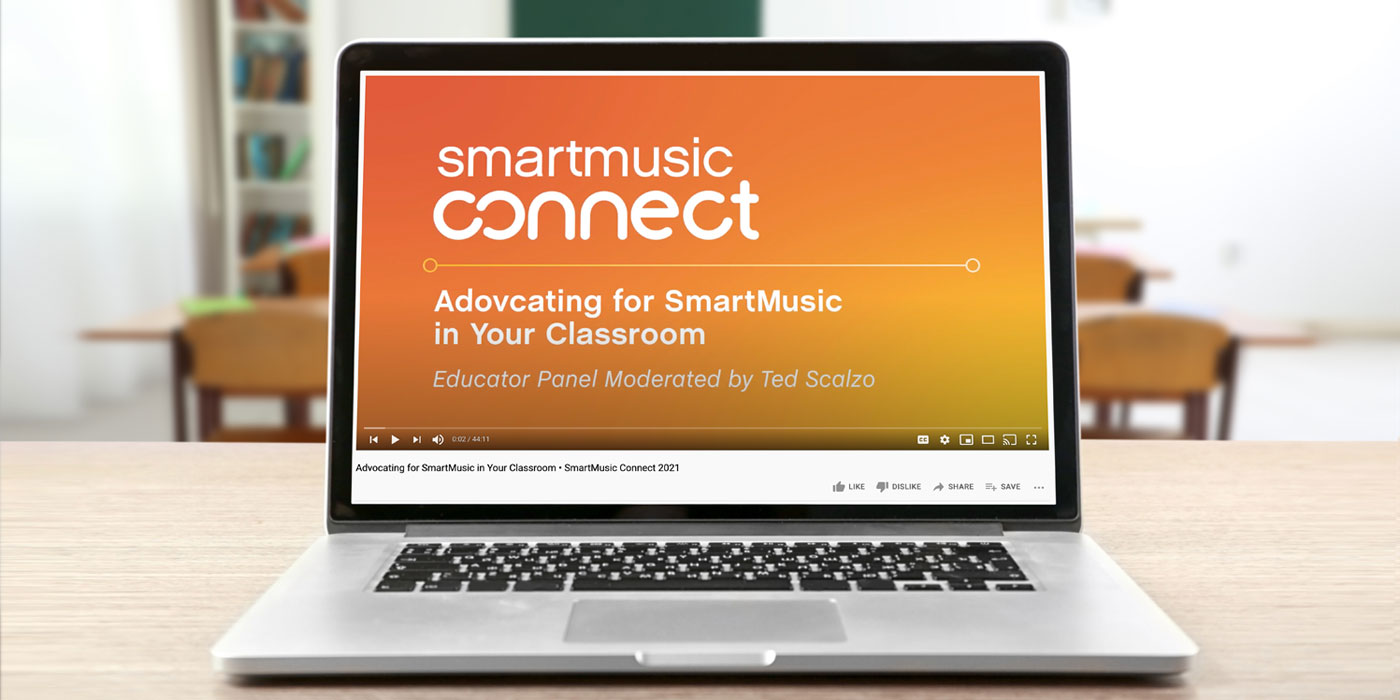
By Krystal Williams and Peggy Rakas
Why advocate for using SmartMusic in the classroom?
As music educators, we are often held to the same standards as our academic core subjects, such as math and English. A lot of initiatives that come from districts ask us how we’re meeting those same standards, requiring us to provide quantifiable data that shows student growth over time.
Below are some of the benefits of implementing SmartMusic in your classroom, as well as strategies for advocating for using SmartMusic as a tool that supports and measures student progress.
The Benefits of SmartMusic
SmartMusic addresses educators’ and students’ needs in full force, arming teachers with quantifiable data and students with access to a repertoire library much larger than most standard physical sheet music budgets provide—in addition to a full suite of practice tools that support effective practice and growth. Some benefits include:
- Accessibility
- Increased student engagement
- Premade units/assignments
- Differentiated and individualized instruction
- Student self-efficacy
- Digital access to literature and method book choices
- Performance examples and models
- Lowers your paper budget
- Social-distance friendly
- Maintains connection between teacher and student outside of the classroom
- Built-in practice analytics—quantifiable data!
- Ability to download student recordings
The Ultimate Deliberate Practice Tool
If the big picture goal is to teach students about how to succeed—and not just play 10,000 hours of “Hot Cross Buns.” The path to success in all fields depends on the ability to expertly and deliberately practice and SmartMusic is the ultimate deliberate practice tool. We need to examine the underlying process of deliberate practice, analyze how it applies to our instruction and to the work done by students outside of class, and understand how SmartMusic is a valuable tool for nurturing this process.
For instance, a student might practice a piece of music (do), and upon reflection, realize that one section needs a lot of work. The plan becomes to work on that section. SmartMusic’s immediate feedback and real-time assessment assists students in the reflection stage, showing missed rhythms and pitches. Practice tools such as the looping feature, metronome, tuner, and tempo adjustment all help with planning to improve. The cycle begins again with another round of practice and playing.

Proof of Student Outcomes
Academic studies also confirm that SmartMusic has a proven, positive effect on student outcomes. For example, studies have shown that for sight-singing assessment, SmartMusic had a positive effect with students scoring an average of 49.4 points higher from Pre-Assessment to Post-Assessment, compared to 29.25 points for students not using SmartMusic. Students also find success using SmartMusic in sight-reading and performance techniques, as shown in the graph below.

How to Advocate for SmartMusic with your District
Take a Data-Driven Approach
“I showed them the gradebook tool in SmartMusic and said, ‘here’s why my group sounds the way they do. They sound good because they have the same tools that math and English [students] have, now through something like SmartMusic.’”—Krystal Williams
If your goal is to keep administrators happy and to defend your grades and the assessment tools that you’re using, SmartMusic is the solution. Many Fine Arts Coordinators and district representatives are looking for quantifiable data that supports the need for providing certain tools—numbers that show why music is important and effective, not just a class that kids take so they can play the songs they like.
While administrators may have an appreciation for music education, they don’t always understand that there is an intellectual process at play. SmartMusic’s Gradebook and practice analytics deliver student growth metrics in a language that the non-musician (administrators) can easily understand. Without a tool to provide the data that districts are looking for, any measurement for student growth would be subjective, making grades and assessment all the more difficult to defend.
Show, Don’t Tell—Schedule a SmartMusic Demo
Scheduling a demonstration for your school board can be an incredibly effective way to show the power of SmartMusic to decision-makers. Ask for a few student volunteers (with parent permission) to attend the meeting and play along with a simple exercise or song, demonstrating the immediate feedback and other tools available in the Practice app. Project the SmartMusic interface on a Smartboard so that meeting attendees can collectively follow along with the cursor on the screen while students play, witnessing the yellow, green, and red notes in real-time assessment.
Learn how to use SmartMusic to help teach National Standards >
Final Advice
Students love technology—we know this because they won’t put away their phones! It’s so important that teachers spend time with the program to familiarize themselves with it and get comfortable operating it. Often, teachers give up on technology because they’re uncomfortable, and that gets projected on our students. There are a lot of wonderful tutorials available through SmartMusic Academy—spend time learning how to navigate the program. The more comfortable you are, the more comfortable the students will be.
In the end, great teaching is about love and connection. With the tools in SmartMusic, teachers have many more avenues to connect with their students. With the practice analysis, we can find out what motivates our students, and we can praise them for how much they have practiced. With the comment sections, we can send messages of encouragement to our students, and they can send messages in return. With the opportunities to individualize instruction we can show our students that we care for their needs. We can inspire them to love music by having them listen to the beautiful recordings on SmartMusic. Love and connection—the ultimate tools for success.

